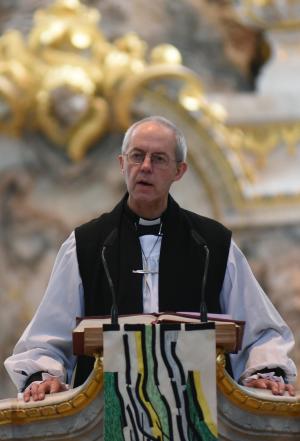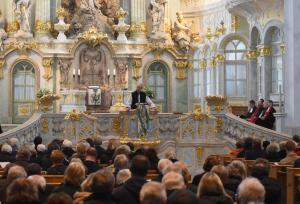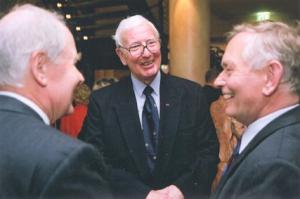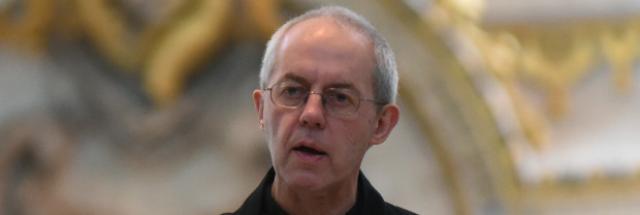Shared sorrow in Dresden
The German President, Joachim Gauck and the Archbishop of Canterbury, Justin Welby, both struck appropriate notes at a moving memorial service in Dresden on 13 February marking the 70th anniversary of the devastating World War II Allied bombing of that historic German city.
President Gauck said, 'We know who started the murderous war, we know it and that's why we will never forget the victims of German warfare. We do not forget, even as we remember here today the German victims. A country that is responsible for a monstrosity like the Holocaust cannot expect to go unpunished and emerge undamaged from a war that it had provoked.'
 Archbishop Welby, who has lived and worked in Coventry, scene of heavy German bombing, and whose uncle, Air Chief Marshal Sir Charles Portal, was a principal advocate of the deliberate bombing of civilian areas, told the Dresden congregation he thought it 'miraculous' that the Germans felt able to welcome him: 'In the rage of war our hearts inevitably harden and increasingly brutal and devastating force is unleashed.' Whatever the arguments, he said, events here 70 years ago left a deep wound and diminished all our humanity: 'There is a deep need for profound sorrow at the events and causes of such a dreadful time as Europe has lived through.'
Archbishop Welby, who has lived and worked in Coventry, scene of heavy German bombing, and whose uncle, Air Chief Marshal Sir Charles Portal, was a principal advocate of the deliberate bombing of civilian areas, told the Dresden congregation he thought it 'miraculous' that the Germans felt able to welcome him: 'In the rage of war our hearts inevitably harden and increasingly brutal and devastating force is unleashed.' Whatever the arguments, he said, events here 70 years ago left a deep wound and diminished all our humanity: 'There is a deep need for profound sorrow at the events and causes of such a dreadful time as Europe has lived through.'
It is a pity that some British newspapers chose to say that the archbishop apologized for the bombing and a celebration of forgiveness became an opportunity for further controversy and blame. The Archbishop did not apologize, as his office made clear, but his words 'were a reflection in a solemn ceremony on the tragedy of war.'
That the bomber crews were incredibly brave and doing their duty, and that some people think that their action may have shortened the war, does not mean that in the presence of those who have suffered we should not reach out with compassion, as the Archbishop demonstrated. He said afterwards on the radio, 'Walking together as friends requires talking together in truth.'
 Two days later Archbishop Welby preached in Dresden’s rebuilt Frauenkirche. He said: 'During my five years in charge of the work at Coventry Cathedral on the Community of the Cross of Nails the story of Dresden, the terrible events of 70 years ago, the appalling suffering of the Europe of those days, all were part of the story which has so shaped my own priority on reconciliation in so many parts of the world,'
Two days later Archbishop Welby preached in Dresden’s rebuilt Frauenkirche. He said: 'During my five years in charge of the work at Coventry Cathedral on the Community of the Cross of Nails the story of Dresden, the terrible events of 70 years ago, the appalling suffering of the Europe of those days, all were part of the story which has so shaped my own priority on reconciliation in so many parts of the world,'
Michael Henderson
Michael Henderson wrote about some of the background to the controversy over the bombing of Dresden and the efforts to bring healing to memories in his book 'No Enemy to Conquer – Forgiveness in an Unforgiving World'
‘WHAT ABOUT DRESDEN?’
Over many years the biggest source of resentment in Germany towards Britain could be encapsulated in the one word – Dresden. On 13-14 February 1945, less than three months before the ending of the war in Europe, one of its most beautiful baroque cities was destroyed by British and American bombers when they dropped 4,500 tons of explosives, creating a firestorm, devastating eight square miles of the city and killing at least 35 to 40,000 men, women and children.
In a remarkable way Dresden is, through honesty, apology and compassion, becoming a focal point of reconciliation between the two countries. The bombing had always been an embarrassment to the British, as the London Times pointed out in February 1995 on the 50th anniversary of the raids, but added that ‘it was being transmogrified into friendship and reconciliation and revitalized understanding of an older, worthier and culturally rich Germany’.
 Physical expression of this transformation is the Frauenkirche. Following the collapse of the Berlin Wall Dresdeners launched a call for help in rebuilding the church. One of the many in Britain who felt strongly that a positive response from Britain was called for was Alan Russell. He grew up during World War II and was proud of what the RAF did to achieve victory. Soon after the war he did military service in the British zone of Germany. While there a German student friend had acknowledged to him that the persecution of the Jews had been a great wrong but had added, ‘What about Dresden?’
Physical expression of this transformation is the Frauenkirche. Following the collapse of the Berlin Wall Dresdeners launched a call for help in rebuilding the church. One of the many in Britain who felt strongly that a positive response from Britain was called for was Alan Russell. He grew up during World War II and was proud of what the RAF did to achieve victory. Soon after the war he did military service in the British zone of Germany. While there a German student friend had acknowledged to him that the persecution of the Jews had been a great wrong but had added, ‘What about Dresden?’
At the time Alan had no answer. But as he read the first of what was to become a number of well-researched books on the subject, he found himself forced to confront the uncomfortable truth that, as one distinguished reviewer put it, ‘something not quite worthy of Britain’ had taken place. Whilst he felt it entirely right to honour the bravery and commitment of the more than 50,000 British Bomber Command crewmen who had sacrificed their lives in the war, he felt that the victims, too, deserved a memorial since innocence, dignity and the sacredness of life itself know no frontiers. It wasn’t wrong to bomb Dresden, he believes, since the outer reaches of the City contained both war industries and military installations but the manner in which it was done, focusing on the historic inner City, was highly questionable. He felt that some sign of atonement and regret for the bombing should be given and that the British public should be given the opportunity to look at Britain’s moral record: ‘Nations must be able to look critically at what has been done in their names in order to have the right to examine what other countries have done.’
He worked with others to set up a Trust for Dresden (1993) to help raise money in Britain for the restoration of the church. He wrote in a Dresden magazine in February 2002, ‘The statement of St Matthew about “the splinter and the moat” remains appropriate. It is for all members of the Trust a challenge to liberate the British and the Germans from the common nightmare of self-righteousness.’
The Trust’s found a ready response round the country and over the following years it raised around £1 million. When in the autumn of 1994, it was invited to undertake the making of the new nine-metre-high baroque Orb and Cross which was to stand on the pinnacle of the dome of the Frauenkirche, it enthusiastically made this the centrepiece of its actions. By a remarkable coincidence Alan Smith, head of Silversmiths Grant Macdonald’s team of skilled workers was the son of one of the airmen who had bombed Dresden, who saw his work as not only a technical challenge but as a deep spiritual fulfilment.
In February 1995, at ceremonies marking the 50th anniversary of Dresden’s destruction, the Duke of Kent presented a drawing of the Orb and Cross and said, ‘We want this Cross to be a symbol of the reconciliation between Britain and Germany. We do this in remembrance of those who died in Dresden in February 1945, and in the conviction that there will forever be peace between our two peoples. We deeply regret the suffering on all side in the war.’
The Times commented, ‘There could be no more fitting gesture. Some Germans may interpret the present as a discreet apology. All can agree that it is a sincere act of reconciliation.’
In June 2004 the Orb and Cross were lifted into place before a crowd of 60,000 people. In October 2005 the Frauenkirche was reconsecrated and the Trust handed over a symbolic gift of Communion Silver Plate. To carry the message further the Trust has published books, given scholarships for young people from Dresden and Saxony to attend schools in England and for young Britons to visit Saxony, arranged for German choirs to sing in Britain, and taken the London Bach Choir to Dresden to give two concerts in the Frauenkirche itself. Alan Russell says, ‘The hand of friendship which the Trust sought to extend was immediately, warmly and firmly grasped and the feelings of deep sorrow and remorse to which the Trust sought to give voice have been reciprocated in more than full measure.’
In October 2006 the Duke of Kent dedicated a British German Friendship Garden in Britain’s National Memorial Arboretum, in honour of all who died in World War II raids. It contains a circle of 14 stones retrieved from the rubble of the Frauenkirche, each inscribed with the names of cities in Germany and Britain damaged or destroyed in the war. A plaque, in German and English, states, ‘Just as the city of Dresden has risen from the ashes of the firestorm which engulfed it, so have the respect that traditionally characterised British German relations been reborn. Henceforth may all difficulties between the two countries be resolved with patience and understanding, may their sorrows be shared and their joys celebrated together. In the beauty of nature as in the presence of God, we are all one.’
Every morning at the National Memorial Arboretum a silence, accompanied by the Last Post and Reveille, is observed at 11 am in honour of those who sacrificed their lives in defence of freedom. This is at the chapel, which the arboretum’s founder David Childs, called the Millennium Chapel of Peace and Forgiveness, rather than of peace and reconciliation, because, he told me, ‘Forgiveness requires a conscious act of will.’
Extract from 'No Enemy to Conquer' Baylor University Press 2009

